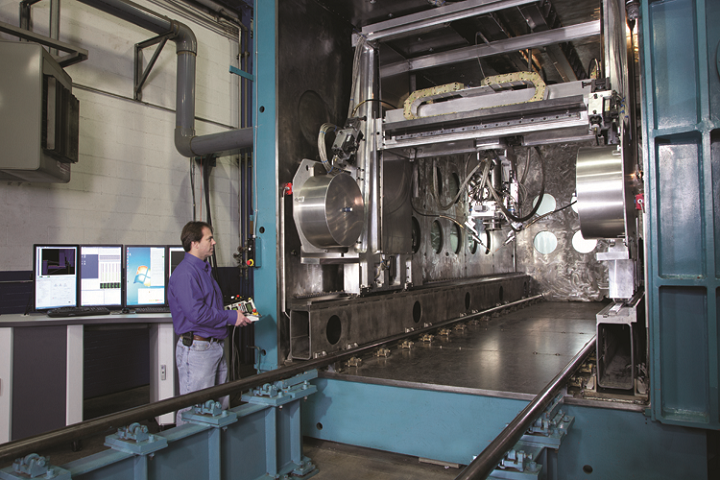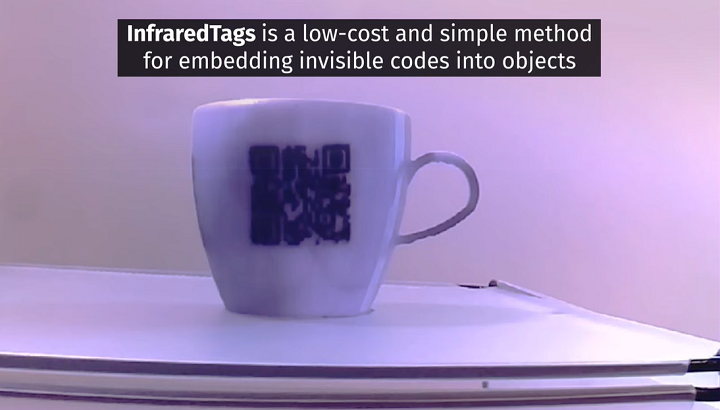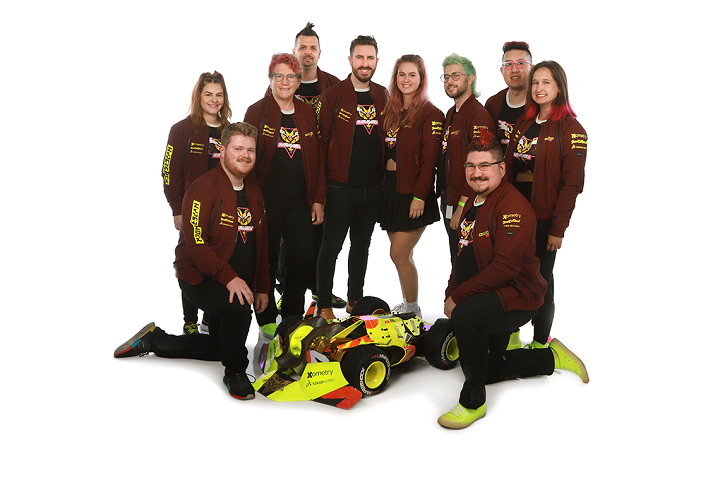Kicking things off in today’s 3D Printing News Briefs, Sciaky will deliver what it calls the “world’s largest” metal electron beam DED 3D printer to an aerospace customer. In research, UCSD and UCLA developed a 3D bioprinted multicellular model of an ocular surface disorder, and MIT CSAIL researchers embedded infrared barcodes in 3D printed objects. Moving on to entertainment and sports, another BattleBots team is using 3D printed parts for its fighting robot, Canadian musician Grimes is wearing a 3D printed costume in her new music video, and a BBC ad for the Winter Olympics features stop motion animation and 3D printed sets.
Sciaky Delivering Custom EBAM 3D Printer to Turkish Aerospace
First up, industrial metal 3D printing solutions supplier Sciaky, Inc., a subsidiary of Phillips Service Industries, Inc. (PSI), announced that it will be delivering a electron beam directed energy deposition (DED) 3D printer to Turkish Aerospace Industries (TAI), which is the technology center for developing, manufacturing, system integration, modernization, and lifecycle support of the country’s aviation and space programs. Sciaky calls the printer—a customized version of its 300 Series Electron Beam Additive Manufacturing (EBAM) System—the largest metal electron beam DED printer in the world, with a work envelope of 6 meters long by 2 meters wide by 1.8 meters high and deposition rates of more than 20 lbs. of metal per hour for many metal alloys. The giant multipurpose 3D printer, which can also switch to an Electron Beam Welder (EBW), will be delivered to TAI’s Ankara, Turkey plant, where it will be used to print some of the industry’s largest titanium aerostructures. Additionally, Sciaky’s contract also includes collaboration on several projects meant to optimize TAI’s use of the 3D printer.
“Sciaky’s EBAM systems are the most widely sold, large-scale DED metal 3D printers in the world, having approved parts on land, sea, air, and space applications. We applaud TAI’s vision for innovation and their ambitious plans to 3D print some of the largest titanium aerostructures in the world,” said Scott Phillips, President of Sciaky, Inc.
Rapid 3D Bioprinting of Multicellular Pterygium Disease Model

(A) Schematics of the DLP bioprinter setup and the photopolymerization process to fabricate hydrogel scaffolds encapsulating hCjSCs. (B) Compressive modulus of the hCjSCs encapsulated in soft and stiff bioprinted scaffolds (mean ± sd, n = 3). (C) The ratio of PI-negative population measured with flow cytometry representing the percentage of viable cells in soft and stiff bioprinted scaffolds cultured for 5 days (mean ± sd, n = 3). (D) Real time qPCR showing the relative mRNA expression of KI67, P63 and PAX6 of hCjSCs in 2D culture condition (2D control) or 3D hydrogel scaffolds with different stiffness (mean ± sd, n = 3, *: P < 0.05, **: P < 0.01, ***: P < 0.001.). (E) Representative immunofluorescence staining and corresponding bright field images of bioprinted hydrogel scaffolds encapsulating hCjSCs after 2 days of culture expressing ΔNP63, PAX6 and KI67. Scale bars: 100 μm.
On to research, as a team from the University of California San Diego (UCSD) and the University of California Los Angeles (UCLA) published a paper about their work using a rapid digital light processing (DLP)- based 3D bioprinting platform to fabricate a 3D multicellular in vitro model of a pterygium microenvironment. Pterygium, which the researchers explained is “a pathological outgrowth of conjunctiva,” is an ocular surface disorder that involves chronic inflammation and neovascularization and can lead to visual impairment. The team used human conjunctival stem cells (hCjSCs), immune cells, and vascular cells in what they called the “first reported 3D in vitro disease model for pterygium,” and they used the method to successfully print hydrogel scaffolds “that support the viability and biological integrity of the encapsulated hCjSCs.” In the future, this 3D bioprinted disease model could be used for drug screening and personalized medicine.
“In this study, we explored the DLP-based 3D bioprinting method for primary hCjSCs and developed a bioprinted multicellular pterygium model,” the researchers wrote. “We first harvested the hCjSCs from donor tissues and expanded them with a feeder-free in vitro culture system. Using a customized DLP-based 3D bioprinter, we printed hydrogel scaffolds that were able to support the viability, stemness, and differentiation potency of encapsulated hCjSCs. Next, we performed multicellular bioprinting that combined hCjSCs along with immune cells and vasculature to develop a bioprinted 3D pterygium model. The bioprinted pterygium model was then subjected to global transcriptomic analysis to in-depth characterize the disease phenotypes. Furthermore, we validated our bioprinted model with published datasets of patient-derived pterygium tissues. The cellular interactions and signaling pathways revealed from the multicellular bioprinted model provide a greater understanding of pterygium pathogenesis.”
MIT CSAIL Researchers Embed Infrared Tags in 3D Printed Objects
Mustafa Doga Dogan, a 4th-year PhD student in MIT’s Department of Electrical Engineering and Computer Science (EECS), wondered if physical objects could somehow be embedded with helpful information about said product, like how digital photos include the location, date, and time. In late 2020, he heard about a smartphone with a camera that used infrared (IR) light, which the naked eye can’t see but has the ability to see through materials that are opaque to visible light. So Dogan partnered with a Facebook research scientist and colleagues at MIT’s Computer Science and Artificial Intelligence Lab (CSAIL) to create InfraredTags, which are durable, invisible, machine-readable labels embedded inside 3D printed objects.
The researchers developed a software user interface that identifies what the tag should look like, and where inside a specific object it can be found. They 3D printed several prototypes of objects with these embedded tags, such as a WiFi router prototype with tags that reveal the network name or password, depending on the perspective it’s viewed from, and mugs with bar codes engraved beneath a 1 mm plastic shell inside the walls, which can be read by IR cameras. Dogan and his colleagues are also investigating the idea of adding IR cameras to augmented reality headsets, so you could potentially wear it to the grocery store and learn about the products there. The team will present their paper on InfraredTags at the upcoming ACM CHI Conference on Human Factors in Computing Systems in New Orleans.
BattleBots Team HyperShock Using Purpose-Built Xometry Parts
Another day, another BattleBots team using 3D printing for their attack robot! This time it’s Team HyperShock, which worked with Xometry to create purpose-built parts for its BattleBot’s self-righting arm. Xometry used CNC machining, urethane casting, and three types of 3D printing—FDM, PolyJet, and SLA—to create the precision parts to spec, which should make for a tough fighter in the BattleBots arena, and helped the team keep costs down and meet a tight timeline, as they only have three months from when the season is announced until filming to design, build, and test their BattleBot. Machining was used to make brackets, couplings, and mounts for the arm, while urethane cast bushings were created to insulate the components from impact; supporting and cosmetic components were 3D printed. Xometry even made two extra sets of parts, which made it easy to service the BattleBot between rounds.
“The parts are dead-on. Everything fits so perfectly, even with the broadest tolerance range,” said mechanical engineer Will Bales, lead designer and team captain of Team HyperShock.
“Xometry can always handle what we throw at them when we need something fast.”
Grimes Wears 3D Printed Costume in New Music Video
We’ve seen musicians utilize 3D printing in music videos before, and recently, American fashion designer Asher Levine, who specializes in digital and high-tech projects and has made garments for Doja Cat, Rita Ora, Lady Gaga, Lil Nas X, and other famous names, created a 3D printed costume for Canadian singer-songwriter Grimes in her “Shinigami Eyes” music video, which debuted last month and features Blackpink K-pop singer Jennie Kim, for whom he also made an outfit. Levine worked with Grimes and her stylist Brett Alan Nelson to create a custom scale-print, light-up nude bodysuit, which features a dragonfly motif and is based on his Tetra collection. He used virtual reality to create a hologram of the bodysuit to place over a scan of the singer’s body, and then used his signature 3D printing method to fabricate the piece, later building a light from inside so it could change colors.
“The Tetra print is inspired by dragonfly wing architecture, so we did a computationally generated scale print and we customized it with a cool unique print,” Levine said.
“I love when people come to me and they’re like, ‘let’s interpret the future. Let’s interpret artificial intelligence.’ I just love being the go-to designer for that. [Grimes and Nelson] let me run with it and she was like, ‘this is cool.'”
Tiny 3D Printed Sets for BBC’s Winter Olympics Ad
Finally, BBC Creative came up with an amazing promotional trailer for the 2022 Winter Olympics in Beijing, which used stop motion animation, in-camera effects, and small 3D printed sets in its production. Balázs Simon directed the trailer through the Blinkink production company, and it features entire 3D printed scenes captured frame by frame with complex camera moves, and then animated to give viewers a super closeup feel of the difficult conditions the athletes are facing. The action starts inside an ice cube, which quickly morphs into moving athletes from a variety of represented events, including skiing and ice skating. Thanks to an algorithmic solution, forced perspective allows the viewer to get a sense of the Olympians’ speed and sense of movement.
“I really admire people having the will to push things to the limits. What could be a better example for that than the Olympics? Especially the Winter Games where they compete in environments that are so different from our usual experiences. When I got approached for this project, the biggest question for me was how to portray and live up to that dedication … we wanted to portray them being born into ice and snow and eventually breaking out,” Simon explained.
“My personal favourite task was coming up with a solution for the camerawork in the snow scenes. To get a first hand experience of the characters’ efforts, I wanted to bring the viewer as close to them as possible: a great example of how a seemingly simple creative decision could grow into a big web of intertwined technical challenges.”
Subscribe to Our Email Newsletter
Stay up-to-date on all the latest news from the 3D printing industry and receive information and offers from third party vendors.
You May Also Like
Gorilla Sports GE’s First 3D Printed Titanium Cast
How do you help a gorilla with a broken arm? Sounds like the start of a bad joke a zookeeper might tell, but it’s an actual dilemma recently faced by...
Nylon 3D Printed Parts Made More Functional with Coatings & Colors
Parts 3D printed from polyamide (PA, Nylon) 12 using powder bed fusion (PBF) are a mainstay in the additive manufacturing (AM) industry. While post-finishing processes have improved the porosity of...
$25M to Back Sintavia’s Largest Expansion of Metal 3D Printing Capacity Since 2019
Sintavia, the digital manufacturing company specializing in mission-critical parts for strategic sectors, announced a $25 million investment to increase its production capacity, the largest expansion to its operations since 2019....
Velo3D Initiates Public Offering in a Bid to Strengthen Financial Foundations and Drive Future Growth
Velo3D (NYSE: VLD) has been among a number of publicly traded 3D printing firms that have attempted to weather the current macroeconomic climate. After posting a challenging financial report for 2023,...


































